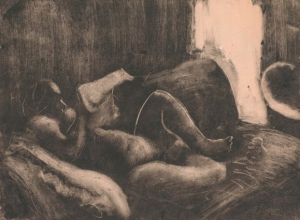The Van Gogh Museum has for the first time acquired a work by Edgar Degas: the La lecture après le bain monotype. A monotype is a print of an ink drawing made on a plate. Degas’ monotypes are rare and they were a hidden treasure, because they never left his studio during his lifetime. La lecture après le bain is the first black monotype in any Dutch public art collection. The Mondriaan Fund and the Rembrandt Association have made this acquisition possible.

The art of Impressionist printmaking
The Van Gogh Museum has been collecting prints for decades, following the example of Vincent van Gogh and his brother Theo. From the moment the museum acquired an important collection of prints in 2000, it has concentrated on collecting prints from the fin de siècle (1890-1905), the period during which the art of printing flourished. Presently, the museum’s collection comprises some 1800 prints of eminent quality from this period and it is also carrying out intensive research into the collection.
The acquisition of La lecture après le bain marks a new focus on collecting, now concentrating on Impressionist printmaking. Theo and Vincent already bought prints by Impressionist artists such as Manet and Pissarro that are now part of the Van Gogh Museum collection. Yet, absent from our collection were highlights of Impressionist printmaking, such as a monotype by Edgar Degas (1834-1917). The Impressionists approached the art of printmaking in a completely novel manner: rather than being interested in reproduction, they emphasized experiment and originality. This tied in with collectors for whom the rare, often unique artistic print became a holy grail during the 1870s. The Impressionist art of printmaking is thus the most important precursor of printmaking dating from the fin de siècle.
Erotic
A monotype (literally: single print) is an ink drawing on a smooth, non-absorbent surface that is then printed. Only one rich black print can be made of a monotype, as in the case of the acquired work. Degas occasionally made one or two more prints, these however are paler. He often used these ghost prints as the basis for pastel drawings. Degas’ monotypes are found in the collections of major museums worldwide; thanks to this acquisition one of those rich black monotypes has now become part of the Dutch public art collection.
La lecture après le bain is intimate as much as it is erotic. A naked woman has settled herself on a chaise longue reading a newspaper in semi-darkness. Degas created the drawing on the surface in black ink by clearing away or scratching with a brush, a needle, a cloth or his fingers. The woman is softly illuminated in the dark interior by light flooding in through a screened window on the right. Her raised leg blocks the light from behind, resulting in a sharp contour. Far to the right is the hardly visible washing tub that explains the title.
Van Gogh and Degas
Van Gogh was greatly influenced by the Impressionists. He especially admired the nudes by Degas and was inspired by them when he created three audacious nudes when living in Paris. Not only was Degas one of the foremost painters and draughtsmen among the Impressionists, he was also an innovative printmaker who was in the vanguard of the revival of printmaking in the late nineteenth century. La lecture après le bain(1879-1883) is a wonderful example of Degas’ daring technical experiments and his unconventional nudes.
La lecture après le bain is a prime example of the type of print that appealed to the Impressionists above all: no large editions or slick prints, but making full use of the expressive and artistic possibilities of the medium. Degas’ black monotypes are rare and they were a hidden treasure because they never left his studio during his lifetime. They were the artist’s highly personal experiments in style, technique and theme that he only showed to a few intimate friends and colleagues.
The Mondriaan Fund and the Rembrandt Association have made this acquisition possible.
 Entrez votre email pour être toujours au courant des nouveautés !
Entrez votre email pour être toujours au courant des nouveautés !